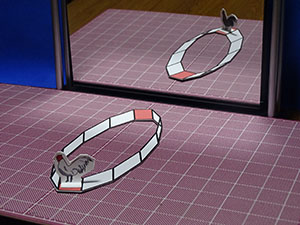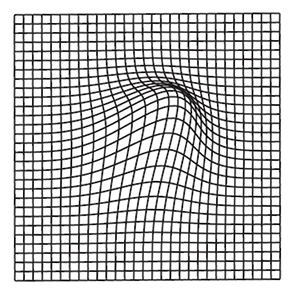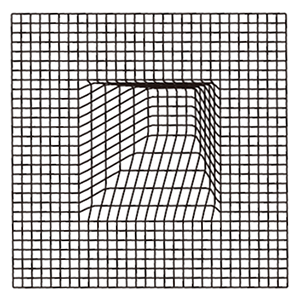To the lecture series English top page
Comments on Lecture 7 "Height-Reversing Objects"
Comment 1. Trick of "Jumpijg Rooster"
 This is a horizontally placed picture of a twelve-gon cylinder on its side together with a chicken which really stands on it. So the height-reversal property holds. However, the twelve-gon cylinder is symmetric with respect to a horizontal plane, and hence it looks as if the object is normally reflected in the mirror. Actulally the height is reversed. Therefore, the chicken jumps up on top. The change from a hen to a rooster is just because we se the front side and the back side of the same piece of paper.
This is a horizontally placed picture of a twelve-gon cylinder on its side together with a chicken which really stands on it. So the height-reversal property holds. However, the twelve-gon cylinder is symmetric with respect to a horizontal plane, and hence it looks as if the object is normally reflected in the mirror. Actulally the height is reversed. Therefore, the chicken jumps up on top. The change from a hen to a rooster is just because we se the front side and the back side of the same piece of paper.
[Additional Remark] Strictly speaking, there is an inconsistency in this object. In the direct view, we see the outer side of the upper half of the cylinder and the inner side of the lower half, and hence there is an occludion; the outer side hides the inner side. In the mirror, on the other hand, the occluding surface and the occluded surface are interchanged. So I drew this part so that both the occluding edge and the occluded edge are visible, intending as if the material is semi transparent. However, this inconsistency is very local, and hence we usually cannt notice.
Comment 2. For Those Who Want to Construct the "Jumping Rooster"
 The picture of the twelve-gon cylinder is placed
here. Print it, place it in front of a vertical mirror, and find appropriate viewpoint and mirror orientation. Then, you will enjoy the illusion. The chicken can be replaced with anything you want.
The picture of the twelve-gon cylinder is placed
here. Print it, place it in front of a vertical mirror, and find appropriate viewpoint and mirror orientation. Then, you will enjoy the illusion. The chicken can be replaced with anything you want.
ā«RDReference on the Height-Reversing Illusion
K. Sugihara: Height reversal generated by rotation around a vertical axis. Journal of Mathematical Psychology, vol. 68-69 (2015), pp. 7-12.
This reference is the same as what I presented in Lecture 3. Actually both the Height-Reversing Objects and the Height-Reversing Staircases are based on the same mathemaitcal principle.
Comment 4. Examples of Pictures Used in the Lecture

 The height-reversing object can be made using the picture projected slantly onto the horizontal plane. This is different from an ordinaly orthogonal projection. Hence we have to see it in the slanted direction. Place a left picture on a horizontal desk, rotate it counterclockwise around the vertical axis by 30 degrees, and look it down in the direction of 45 degrees measured from the horizontal direction. Then, you can perceive a normal surface.
The height-reversing object can be made using the picture projected slantly onto the horizontal plane. This is different from an ordinaly orthogonal projection. Hence we have to see it in the slanted direction. Place a left picture on a horizontal desk, rotate it counterclockwise around the vertical axis by 30 degrees, and look it down in the direction of 45 degrees measured from the horizontal direction. Then, you can perceive a normal surface.
 This is a horizontally placed picture of a twelve-gon cylinder on its side together with a chicken which really stands on it. So the height-reversal property holds. However, the twelve-gon cylinder is symmetric with respect to a horizontal plane, and hence it looks as if the object is normally reflected in the mirror. Actulally the height is reversed. Therefore, the chicken jumps up on top. The change from a hen to a rooster is just because we se the front side and the back side of the same piece of paper.
This is a horizontally placed picture of a twelve-gon cylinder on its side together with a chicken which really stands on it. So the height-reversal property holds. However, the twelve-gon cylinder is symmetric with respect to a horizontal plane, and hence it looks as if the object is normally reflected in the mirror. Actulally the height is reversed. Therefore, the chicken jumps up on top. The change from a hen to a rooster is just because we se the front side and the back side of the same piece of paper.
 The picture of the twelve-gon cylinder is placed
here. Print it, place it in front of a vertical mirror, and find appropriate viewpoint and mirror orientation. Then, you will enjoy the illusion. The chicken can be replaced with anything you want.
The picture of the twelve-gon cylinder is placed
here. Print it, place it in front of a vertical mirror, and find appropriate viewpoint and mirror orientation. Then, you will enjoy the illusion. The chicken can be replaced with anything you want.

 The height-reversing object can be made using the picture projected slantly onto the horizontal plane. This is different from an ordinaly orthogonal projection. Hence we have to see it in the slanted direction. Place a left picture on a horizontal desk, rotate it counterclockwise around the vertical axis by 30 degrees, and look it down in the direction of 45 degrees measured from the horizontal direction. Then, you can perceive a normal surface.
The height-reversing object can be made using the picture projected slantly onto the horizontal plane. This is different from an ordinaly orthogonal projection. Hence we have to see it in the slanted direction. Place a left picture on a horizontal desk, rotate it counterclockwise around the vertical axis by 30 degrees, and look it down in the direction of 45 degrees measured from the horizontal direction. Then, you can perceive a normal surface.